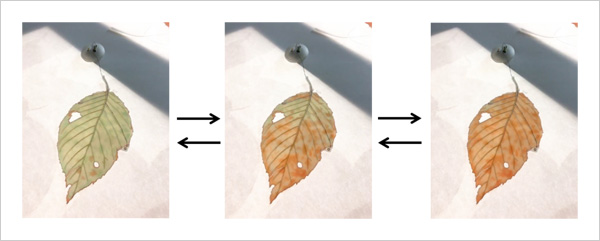Artwork with Nonvolatile Soft Display, Expressing Color Gradation
2019.11.25
National Institute for Materials Science (NIMS)
Waseda University
Tama Art University
Japan Science and Technology Agency (JST)
NIMS, Waseda University and Tama Art University developed a nonvolatile “soft display” that can express color gradation within a single pixel. The joint research group succeeded in fabricating a leaf-shape display which reproduced natural gradient-tinting.
Abstract
- NIMS, Waseda University and Tama Art University developed a nonvolatile “soft display” that can express color gradation within a single pixel. The joint research group succeeded in fabricating a leaf-shape display which reproduced natural gradient-tinting. This technology allows artistic expression beyond imitation of natural processes, potentially enabling the creation of new forms of art that would be impossible to produce using existing digital art techniques.
- Digital artwork is becoming increasingly popular in parallel with the development of ultra-high-definition displays (e.g., 4K/8K technologies) and advances in image processing techniques. However, the use of liquid crystal and organic electroluminescent displays in digital art limits the range of artistic inspiration and expression due to the intrinsic characteristics of these devices (e.g., square pixels arranged in a grid pattern, the need for a continuous electricity supply to maintain the display, limited color expression due to finite conditions associated with digital technology and the exclusion of unpredictable effects generated by noises and accidents).
- The joint group succeeded in fabricating a leaf-shape display with infinite resolution, reproducing the way in which natural leaves change color. Upon applying a voltage to the “leaf”, red areas spread over the green leaf. When switched off halfway, the color pattern is maintained. Moreover, it recovered to the original green electrochemically. The display is composed of two flexible, transparent electrode films, an electrochromic (EC) metallo-supramolecular polymer layer, an electrolyte layer, and a counter material layer. The electrode films were processed into a leaf shape using laser. An electrode wiring process and the formation of leaf vein patterns were also developed. The process in which autumn leaves change color through the spreading and blending of different colors was reproduced by forming multiple layers of the EC polymer. After the display turns completely red, its color can be reversed to green. Finally, when the display is switched off, it can continue to display the coloration as of the moment it is shut down.
- This project was jointly carried out by a research group led by Masayoshi Higuchi (Leader of the Electronic Functional Macromolecules Group, Research Center for Functional Materials, NIMS), the Research Organization for Nano & Life Innovation (Waseda University) and the Faculty of Art and Design (Tama Art University). This work was conducted as part of another project entitled “Ultrafast, ultralow-power, ultralarge-area electrochromism” (research director: Masayoshi Higuchi) being carried out in the research area “Innovative nano-electronics through interdisciplinary collaboration among material, device and system layers” (research supervisor: Takayasu Sakurai) funded by the JST Strategic Basic Research Program CREST. This research was presented under the title, “Nature-inspired flexible electrochromic devices” at the International Display Workshop (IDW19) held at the Sapporo Convention Center from November 27 to 30, 2019.

Figure 1. A leaf-shape EC device capable of changing color gradually like a fall leaf when electric current passes through it.
Related files
- Research Center for Functional Materials
Contacts
(Regarding this research)
-
Masayoshi Higuchi
Group Leader,
Electronic Functional Macromolecules Group,
Organic Molecules and Polymers Field
Research Center for Functional Materials
National Institute for Materials Science (NIMS)
Tel: +81-29-860-4744
E-Mail: HIGUCHI.Masayoshi=nims.go.jp
(Please change "=" to "@") -
Keishi Ohashi
Professor
Research Organization for Nano & Life Innovation
Waseda University
Tel: +81-3-5286-8341
E-Mail: k-ohashi=aoni.waseda.jp
(Please change "=" to "@") -
Yoshiharu Hamada
Professor
Department of Product and Textile Design
Faculty of Art and Design
Tama Art University
Tel: +81-42-679-5624
E-Mail: hamada=tamabi.ac.jp
(Please change "=" to "@") -
Akihiko Kubota
Professor
Department of Information Design
Tama Art University
Tel: +81-42-679-5634
E-Mail: kubotaa=tamabi.ac.jp
(Please change "=" to "@")
(Regarding JST projects)
-
Tsuyoshi Nakamura
Green Innovation Group, Department of Strategic Basic Research
Japan Science and Technology Agency
K's Gobancho, 7 Gobancho, Chiyoda-ku, Tokyo 102-0076, Japan
Tel: +81-3-3512-3531
Fax: +81-3-3222-2066
E-Mail: crest=jst.go.jp
(Please change "=" to "@")
(General information)
-
Public Relations Office
National Institute for Materials Sciences
Tel: +81-29-859-2026
Fax: +81-29-859-2017
E-Mail: pressrelease=ml.nims.go.jp
(Please change "=" to "@") -
Public Relations Division
Japan Science and Technology Agency
5-3 Yonbancho, Chiyoda-ku, Tokyo 102-8666, Japan
Tel: +81-3-5214-8404
Fax: +81-3-5214-8432
E-Mail: jstkoho=jst.go.jp
(Please change "=" to "@") -
Information and Public Relations Section
Office of Information and Public Relations
Waseda University
Tel: +81-3-3202-5454
Fax: +81-3-3202-9435
E-Mail: koho=list.waseda.jp
(Please change "=" to "@")
Same Keywords
Recent Press Release
-
Simultaneous Imaging of Intracellular DNA and RNA Using Harmless Light
2025.10.27
-
Development of an AI Device Using Ion Gel and Graphene That Dramatically Streamlines Machine Learning Computations
2025.10.14
-
Demonstrating a Novel Method to Modulate Heat Flow Through the Collective Motion of Spins
2025.10.06
